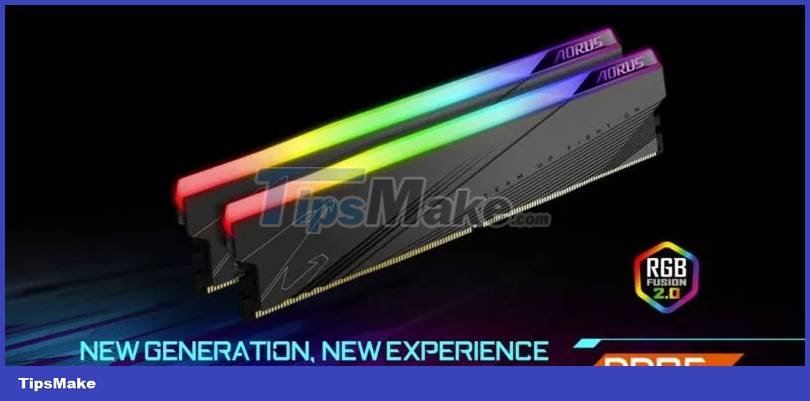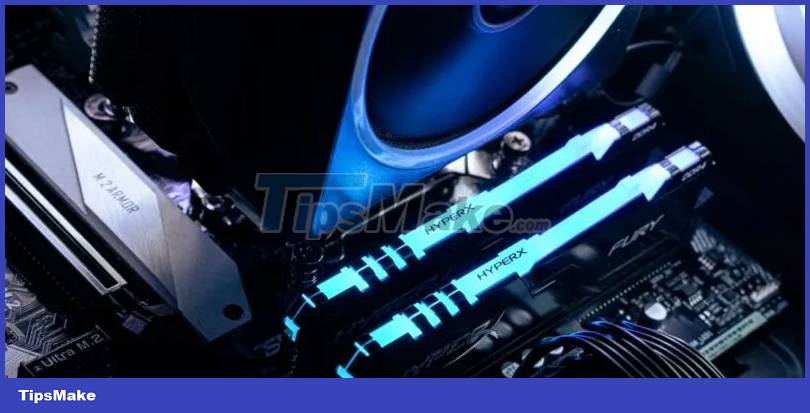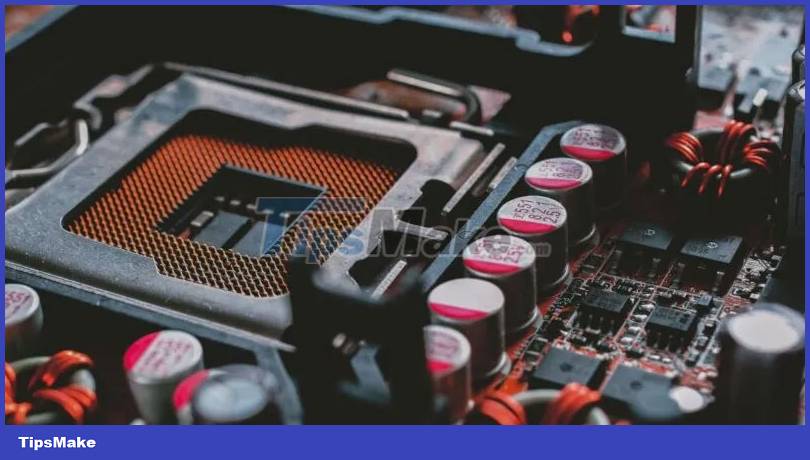Is DDR4 or DDR5 RAM better for you?
Although they were the first processors to support the latest memory standard, but the 13th Gen Ryzen 7000 CPUs from Intel and AMD also offer DDR5 support. If you're building a new PC or debating whether to upgrade your PC's memory, there's a lot to learn when comparing DDR4 and DDR5. This guide looks at the differences between these two types of RAM to help you decide whether to upgrade.
1. Speed
If you look for DDR5 memory cards (DIMMs), one of the first things you'll notice is a significantly higher memory speed or frequency than DDR4 RAM. Although DDR4 RAM sticks typically top out at 5000MHz, you'll be hard-pressed to find a DDR5 stick slower than 4800MHz. This higher memory speed is one of the main highlights of the new DDR5, and one of the main reasons to upgrade from DDR4.

The higher bandwidth of DDR5 RAM has been shown to improve in-game frame rates, albeit by a small margin. But as games become more demanding and even push the fastest CPUs to their limits, faster memory will make more of a difference going forward.
For productivity-oriented users, DDR5's higher bandwidth will be more than welcome. For those who build PCs for long-term use, it is reasonable to buy DDR5 memory if the price difference compared to DDR4 is not too high.
2. Capacity
Memory capacity is another aspect that has improved with the introduction of the DDR5 standard. Most commercially available DDR4 RAM sticks come in 8GB and 16GB variants, up to 32GB. If you need to go above that while still using the DDR4 standard, availability and price will become limiting factors.

In contrast, DDR5 memory cards have a minimum of 16GB and 32GB models are also widely available. With compatible mainboards, this will allow users to double the maximum amount of RAM to 128GB using four 32GB sticks.
It should be noted that before purchasing hundreds of these hot new high-capacity DDR5 sticks, you should determine your computer's maximum amount of RAM.
3. Energy Efficiency
With the new generation of memory, you can expect increased power requirements. But the operating voltage of DDR5 is 1.1V, a drop of 0.1V compared to DDR4. This difference may sound insignificant, but consider that DDR5 is improving performance at a higher level while requiring less power. This makes the new memory standard much more energy efficient than the previous one.

Another important change seen in DDR5 RAM is the move of voltage regulation from the motherboard to the DIMMs themselves. This move to integrated power regulation will certainly allow manufacturers to simplify motherboard designs and give them more control over the quality of components. Even the higher operating temperatures in the DDR5 stick shouldn't be a problem, as the onboard heatsinks are more than enough to keep the device cool.
4. Channel configuration
You may have heard that running dual channel RAM offers more performance than single channel RAM. Previously this meant using at least two DIMMs for DDR4 memory, but now only a single stick per DDR5 memory is required, as DDR5 RAM has two 32-bit channels per DIMM instead of just one 64-bit channel. bits on DDR4. This allows the processor to access the same memory card multiple times simultaneously.

The dual-channel configuration on a single DIMM allows DDR5 memory to perform more efficiently than DDR4 memory, reducing latency even further and improving performance in many scenarios.
5. ECC
ECC or Error Correction Code is a feature supported by dedicated memory and motherboards to ensure that data resides in memory and is transmitted to the processor without errors. The DDR5 standard brings this functionality to standard DIMMs by adding an integrated chip. In contrast to DDR4 RAM, data stored on DDR5 RAM will be checked and repaired in case of damage.

However, this implementation of ECC is not ideal because data integrity is only guaranteed for data stored temporarily in RAM. It does not do so for data transferred to the CPU. Therefore, any problems during the transfer will require additional ECC functionality to ensure repair. However, servers and enterprise setups will use both on-die ECC and standard ECC to ensure data integrity.
6. Price
The performance improvements in DDR5 come at a price that doesn't come cheap. Existing 16GB x 2 DDR5 kits can be 50 to 100% more expensive than comparable DDR4 kits. While the high price of DDR5 has dropped a bit over the past two years and will fall even more as the technology evolves, users must consider whether the investment is worth it. Even new system builders can save a lot by choosing DDR4 without sacrificing performance.

DDR5 is still a new technology and it will take a few years to be as commercial as DDR4 is today. If your budget allows, you should switch to a newer memory standard. But if you have allocated most of your budget to components like CPU and GPU, then choosing older DDR4 memory is not a bad choice. This is especially true for gamers who don't sacrifice much performance but save quite a bit of money by sticking with the old standard.
7. Platform compatibility
The high price tag for DDR5 can add up if you factor in the full platform costs. DDR5 DIMMs are not backward compatible with DDR4 motherboards. Therefore, you must invest in a DDR5-compatible motherboard and CPU to fully upgrade to the new standard. This is more complicated on Intel's part, as 12th and 13th generation processors support DDR4 and DDR5 memory standards. You will need to be careful when choosing your motherboard, as similar chipset models come in DDR4 and DDR5 variants.

On the AMD side, things are much simpler, as the latest Ryzen 7000 processors are only compatible with DDR5 RAM. There is no room for confusion, as the newer AM5 platform has discontinued support for DDR4 altogether. But using AM5 will cost you more than Intel's 12th Gen or 13th Gen platforms. AM5 chipset motherboards are more expensive than Intel's LGA 1700 chipset motherboards and will force you to increase your budget.
Should I choose DDR4 or DDR5?
The choice between DDR4 and DDR5 basically depends on the lifecycle of your computer and the workload you are targeting. If you're building a PC from scratch and are willing to spend a bit more, it might make sense to buy compatible DDR5 memory, motherboards, and CPUs.
However, if you're considering upgrading your existing RAM on a DDR5-ready setup, it's better to wait a while if possible. The price of DDR5 memory will continue to fall as manufacturers begin to offer them in more quantities.
Second, upgrading from DDR4 to DDR5 memory for increased gaming performance is not a wise move. You won't get as much performance as you need for the money. But if you're considering DDR5 RAM for professional workloads, you'll be able to take full advantage of DDR5's higher capacity and increased speed.
You should read it
- 10 best DDR4 RAM to improve PC performance
- Compare SDRAM, DDR, DDR2, DDR3, DDR4, and DDR5
- Compare DDR3 and DDR4
- What is DDR4 RAM? Difference between DDR4 RAM and DDR3 RAM
- CPU-Z has a new version, adds support for Alder Lake chips, DDR5, XMP 3.0
- G.Skil's Trident Z Royal Series RAM makes the technology world overwhelmed by ... so beautiful
- Learn about DDR6 RAM
- 5 best B760 motherboards in 2024
May be interested
- CPU-Z has a new version, adds support for Alder Lake chips, DDR5, XMP 3.0
 cpuid has just officially released a major update 1.97 for the famous cpu-z spec reader. the new version comes with support for intel's upcoming 12th generation alder lake processors, 600-series chipsets, and ddr5 memory.
cpuid has just officially released a major update 1.97 for the famous cpu-z spec reader. the new version comes with support for intel's upcoming 12th generation alder lake processors, 600-series chipsets, and ddr5 memory. - V-Color Unveils World's First RGB O CUDIMM DDR5: Overclocking Speed Up to 9200MT/s
 v-color has officially become the first memory manufacturer to launch a commercial rgb ddr5 o cudimm (overclocked cudimm) ram product capable of reaching transfer speeds of up to 9200mt/s (mt/s).
v-color has officially become the first memory manufacturer to launch a commercial rgb ddr5 o cudimm (overclocked cudimm) ram product capable of reaching transfer speeds of up to 9200mt/s (mt/s). - Samsung begins mass production of 'most advanced' 12nm DDR5 memory chips
 samsung electronics has just announced that the company has started mass production lines for the new generation ddr5 dram memory chip line.
samsung electronics has just announced that the company has started mass production lines for the new generation ddr5 dram memory chip line. - G.Skil's Trident Z Royal Series RAM makes the technology world overwhelmed by ... so beautiful
 although it was on display at computex 2018, when gkill launched the high-end ram series trident z royal series ddr4 rgb memory, the world of technology still couldn't be surprised by its beauty.
although it was on display at computex 2018, when gkill launched the high-end ram series trident z royal series ddr4 rgb memory, the world of technology still couldn't be surprised by its beauty. - Learn about DDR6 RAM
 ram development has always been a hectic process. with ddr5 now gaining mainstream acceptance, users are looking forward to the next version and what ddr6 ram can bring.
ram development has always been a hectic process. with ddr5 now gaining mainstream acceptance, users are looking forward to the next version and what ddr6 ram can bring. - 5 best B760 motherboards in 2024
 if you don't want to splurge on an expensive z790 motherboard, you can still build a budget-friendly intel 14th or 13th generation machine with the b760 motherboard and enjoy the latest features like pcie 5.0 and ddr5.
if you don't want to splurge on an expensive z790 motherboard, you can still build a budget-friendly intel 14th or 13th generation machine with the b760 motherboard and enjoy the latest features like pcie 5.0 and ddr5. - The price of RAM is very low, this is a reasonable time for you to upgrade your PC
 the current price of ram has dropped by half, perhaps this is the lowest level in many years. what's happening?
the current price of ram has dropped by half, perhaps this is the lowest level in many years. what's happening? - Intel officially introduced Optane memory
 the new memory has higher capacity and durability, but still fits into the slot of ddr4, incorporating many useful features.
the new memory has higher capacity and durability, but still fits into the slot of ddr4, incorporating many useful features. - Choosing memory for your computer
 instructions on how to choose the right ram for your computer for your needs
instructions on how to choose the right ram for your computer for your needs - EVGA Z590 DARK Premium Motherborad: 21-phase VRM, DDR4-5333+ OC support, $599
 so after a long wait and countless rumors, evga has finally officially released the most impressive motherboard model for intel's mainstream cpu platforms to date.
so after a long wait and countless rumors, evga has finally officially released the most impressive motherboard model for intel's mainstream cpu platforms to date.










 5 best single-board x86 computers in 2023
5 best single-board x86 computers in 2023 The 12th and 13th generation Core CPUs were so good that AMD almost lost the PC market to Intel
The 12th and 13th generation Core CPUs were so good that AMD almost lost the PC market to Intel Top most powerful Dimensity chips in 2023
Top most powerful Dimensity chips in 2023 AMD Ryzen 7 7800X3D Official Benchmark Results Available: 24% Better Gaming Than Intel 13900K At $449
AMD Ryzen 7 7800X3D Official Benchmark Results Available: 24% Better Gaming Than Intel 13900K At $449 Why do some modern computers still have Serial ports?
Why do some modern computers still have Serial ports? AMD confirms Radeon GPU driver update can damage Windows setup, users note
AMD confirms Radeon GPU driver update can damage Windows setup, users note